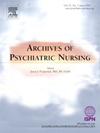狗辅助治疗对成年自闭症谱系障碍患者生物力学和功能参数的影响:一项非随机对照试验
IF 2.2
4区 医学
Q1 NURSING
引用次数: 0
摘要
狗辅助疗法(DAT)是一种补充疗法,可以在不同的人群中产生几种治疗效果,但很少有研究表明它对成人自闭症谱系障碍(ASD)的益处。因此,本研究旨在探讨DAT在成人ASD患者中的生物力学和功能益处。该研究是一项遵循CONSORT指南的非随机对照临床试验,有25名ASD成年人参加。其中12人参加了为期10周的狗辅助干预,每周两次,由一个多学科团队进行。结果显示,完成狗辅助干预的成年ASD患者在步态(p = 0.041)、平衡(p = 0.020)和跌倒风险(p = 0.022)方面均有组内改善。然而,与对照组没有发现差异。关于跌倒的次数,所有在de - DAT之前经历过跌倒的成年人在干预后跌倒的次数都减少了。这些结果表明,在有困难或严重残疾的患者群体中,DAT有可能解决身体问题。本文章由计算机程序翻译,如有差异,请以英文原文为准。
Impact of dog-assisted therapy on biomechanical and functional parameters in adults with autism spectrum disorder: A non-randomized controlled trial
Dog-assisted therapy (DAT) is a complementary therapy that can lead to several therapeutic benefits in different populations, but little investigation has been made about its benefits in adults with autism spectrum disorder (ASD). Thus, the present study aimed to explore the biomechanical and functional benefits of DAT in adults with ASD. The study was a non-randomized controlled clinical trial following the CONSORT guidelines, in which 25 adults with ASD participated. Twelve of them were involved in a dog-assisted intervention twice a week with a multidisciplinary team for 10 weeks. Results showed a within-group improvement in the gait (p = 0.041), balance (p = 0.020) and risk of falling (p = 0.022) of adults with ASD who completed dog-assisted intervention. However, no differences were found with the control group. Regarding the number of falls, all the adults who experienced a fall before de DAT decreased its number after the intervention. These results suggest the potential of DAT to address physical problems in groups of patients with difficulties or severe disabilities.
求助全文
通过发布文献求助,成功后即可免费获取论文全文。
去求助
来源期刊
CiteScore
3.70
自引率
0.00%
发文量
131
审稿时长
160 days
期刊介绍:
Archives of Psychiatric Nursing disseminates original, peer-reviewed research that is of interest to psychiatric and mental health care nurses. The field is considered in its broadest perspective, including theory, practice and research applications related to all ages, special populations, settings, and interdisciplinary collaborations in both the public and private sectors. Through critical study, expositions, and review of practice, Archives of Psychiatric Nursing is a medium for clinical scholarship to provide theoretical linkages among diverse areas of practice.

 求助内容:
求助内容: 应助结果提醒方式:
应助结果提醒方式:


